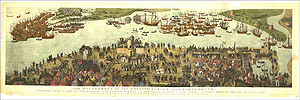Battle of the Solent
| Battle of the Solent | |||||||
|---|---|---|---|---|---|---|---|
| Part of the Italian War of 1542–46 | |||||||
 The "Cowdray engraving" of the battle, c. 1545 |
|||||||
|
|||||||
| Belligerents | |||||||
|
|
|
||||||
| Commanders and leaders | |||||||
| Claude d'Annebault | John Dudley | ||||||
| Strength | |||||||
| 30,000 soldiers in more than 200 ships | 12,000 soldiers in 80 ships | ||||||
| Casualties and losses | |||||||
| ? | about 400 lost in sinking of "Mary Rose" | ||||||
The naval Battle of the Solent took place on 18 and 19 July 1545 during the Italian Wars between the fleets of Francis I of France and Henry VIII of England, in the Solent between Hampshire and the Isle of Wight. The engagement was inconclusive, and is most notable for the sinking of the English carrack Mary Rose.
In 1545 Francis launched an invasion of England with 30,000 soldiers in more than 200 ships. Against this armada — larger than the Spanish Armada forty-three years later — the English had about 12,000 soldiers and 80 ships.
The French expedition started disastrously, the flagship Carraquon perishing on 6 July in an accidental fire whilst at anchor in the Seine. Admiral Claude d'Annebault transferred his flag to La Maistresse, which then ran aground as the fleet set sail. The leaks were patched and the fleet crossed the Channel. The French entered the Solent and landed troops on the Isle of Wight.
On 18 July the English came out of Portsmouth and engaged the French at long range, little damage being done on either side. La Maitresse was close to sinking due to her earlier damage, but although d'Annebault had to change his flagship again, she was saved.
On the night of 18 July, Henry dined aboard Great Harry, the flagship of Admiral John Dudley, Viscount Lisle.
The next day was calm, and the French employed their galleys against the immobile English vessels. Toward evening a breeze sprang up, and as Mary Rose, the flagship of Vice Admiral George Carew, advanced, she foundered and sank with the loss of all but 35–40 of her crew. The precise reasons are not known, but it was believed at the time that the crew had forgotten to close the lower gunports after firing, so that when she heeled over in the breeze she took on water and sank. A witness with the French fleet believed that the galleys had sunk her, although this is not supported by other contemporary accounts and no physical evidence of this remains.
...
Wikipedia
